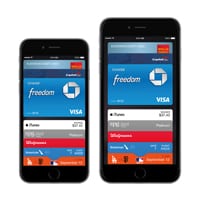 The mobile wallet has been around for the greater part of the 21st century. But Apple’s announcement of Apple Pay for iOS 8 devices has industry experts suddenly abuzz about mobile wallet adoption.
The mobile wallet has been around for the greater part of the 21st century. But Apple’s announcement of Apple Pay for iOS 8 devices has industry experts suddenly abuzz about mobile wallet adoption.
“Apple’s announcement is the kick in the pants that mobile commerce needed,” said Dov Cohn, general manager of mobile solutions for Bronto.”Apple Pay, integrated into the iPhone and available to any mobile app, directly answers two of the key shopping concerns of digital consumers – ease of use and security – and should get consumers to open their mobile wallets.”
[RELATED: Apple Launches Apple Pay, Jumps Into Mobile Wallet Arena]
Apple Pay will work in stores with iPhone 6, iPhone 6 Plus and Apple Watch. Apple Pay APIs will be available to developers in iOS 8 so they can enable purchasing physical goods within their apps on iPhone 6 and iPhone 6 Plus.
“Apple’s foray in to NFC is a landmark and will ignite the mobile payments market globally, but especially in the U.S. where adoption has lagged,” said Pascal Caillon, General Manager North America for Proxama, a global platform provider of proximity marketing, loyalty and contactless payment solutions. “While Apple Pay will make use of mobile payments more palatable and interesting to many more people, the really interesting thing about what the new iPhone’s NFC capabilities will bring is everything else the technology could provide beyond just payments.”
[RELATED: Staples, Whole Foods to Accept Apple Pay]
Apple Pay works with iPhone 6 and iPhone 6 Plus through a groundbreaking NFC antenna design, a dedicated chip called the Secure Element, and the security and convenience of Touch ID.
Apple Pay will also work with the newly announced Apple Watch, extending Apple Pay to over 200 million owners of iPhone 5, iPhone 5c and iPhone 5s worldwide.
Q&A with Ralf Gladis of @Computop: What #ApplePay Means for Omnichannel Retail http://t.co/XpsyOzZGR9
— Tim Parry (@ParryMCM) September 13, 2014
James Yancey, CEO and Co-founder of NFC customer experience provider CloudTags, said Apple’s decision to bring NFC to its new mobile devices will usher in widespread adoption of the technology in the mobile space.
“For retailers, this development presents especially exciting potential,” Yancey said. “Not only can the 80-plus percent of consumers who use their smartphones while shopping now pay for their purchases with a simple tap through Apple Wallet, thus saving immense time at the end of the shopping experience, but there is potential in the future for them to interact more fully with the stores while doing the actual shopping via the Apple API they announced today”
Yancey added that if Apple were to open NFC up beyond payments, retailers will be able to provide an enhanced experience with much greater customer digital participation with products in the store. “Shoppers will be able to access information such as product photos, reviews, video and, more by tapping their devices without having to download an app to their phone, and in turn, retailers will be the recipients of valuable customer intent data from the physical store,” Yancey said.
In addition to the 258 Apple retail stores in the U.S., some of the nation’s leading retailers that will support Apple Pay include Bloomingdale’s, Disney Store and Walt Disney World Resort, Duane Reade, Macy’s, McDonald’s, Sephora, Staples, Subway, Walgreens and Whole Foods Market.
John Haro, CTO of mobile marketing firm Vibes, said he believes Apple Pay will be successful because Apple is able to learn from mistakes made by others who have launched mobile wallets in the past.
“There are a number of challenges that Google Wallet has faced as a pure payment platform, especially in its early days,” Haro said. “For the consumer, it was very confusing as to if you even had the kind of phone that could do payments. Then you would have to set up Google Wallet, and several providers actively blocked the Google Wallet app from their Android phones.”
There was an equal level of confusion and competition on the merchant side, which Haro said also slowed adoption.
“Apple Pay has several advantages coming into payments late in the game, compared to Google Wallet,” Haro said. “Merchants have had some years to upgrade their point of sale systems, consumers are more accustomed to using smart-phones for everything, and Apple’s control over both the hardware and software in the iPhone and Apple Watch lets them make a simple payment system that is easier, and more secure, than simply swiping a plastic card.”
Attaching Apple Pay to the already existing Passbook also gives Apple an advantage, Haro said, because many brands and merchants are already putting their loyalty cards and offers into Passbook.
“With Passbook at the center of Apple Pay, I think there are many ways that merchants will be able to interact with their customers,” Haro said. “Apple Pay inside of an app removes a ton of the complexity of mobile commerce and will undoubtedly unlock many new channels for merchants to connect with their customers.”
